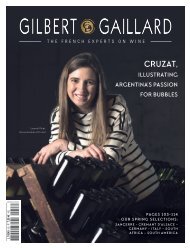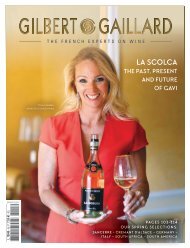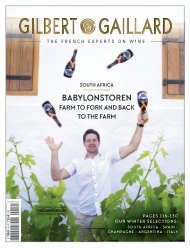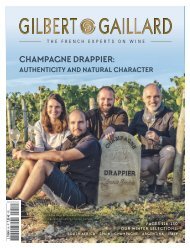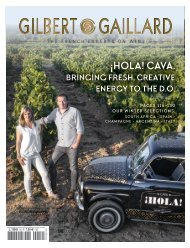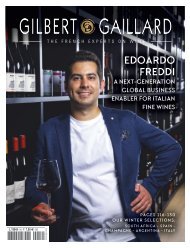You also want an ePaper? Increase the reach of your titles
YUMPU automatically turns print PDFs into web optimized ePapers that Google loves.
THIERRY GIBELIN, THOMAS GIBELIN AND PATRICK ARNOULD<br />
towards more single vineyard offerings. Fortunately, despite their number, the<br />
blocks are all located in 7 or 8 small localities, which means that some fruit can be<br />
harvested and fermented together. For example, the range features a ‘Mémoire de<br />
Vignes’ label made from vines that are over 60 years old. For its non-vintage Brut<br />
Chardonnay, the company swaps some Pinot noir for Chardonnay in order to add<br />
a little acidity. “But the Chardonnays come from a colleague in Le Mesnil sur Oger<br />
– we stay within the privileged realms of the Grands Crus!”<br />
So is a Grand Cru Champagne better? Understandably, the complex winemaking<br />
and maturation techniques and extreme variety of this majestic pour means that<br />
there is no one-size-fits-all answer. Despite this, it is tempting to say that terroir<br />
speaks loudest and these Champagnes always deliver that extra spark of spirit and<br />
the richness and complexity that have carved out their reputation. The Grands Crus<br />
embody artisanal winegrowing that plays second fiddle – both in volume and awareness<br />
– to the mass-market Champagnes sold every year. Either way, they offer the<br />
assurance of a return to Champagne’s roots, the certainty of tasting the reality of<br />
Champagne’s vineyard sites in an increasingly globalised world. For this reason<br />
alone, these superlative quality Champagnes will always deserve our attention.<br />
28 WINTER 2022 • GILBERT & GAILLARD - THE <strong>FR</strong>ENCH EXPERTS ON WINE



